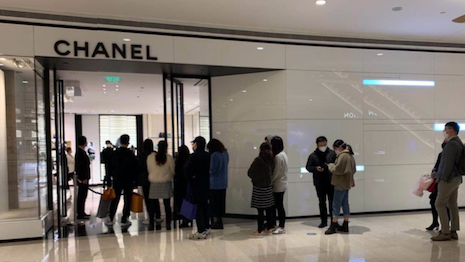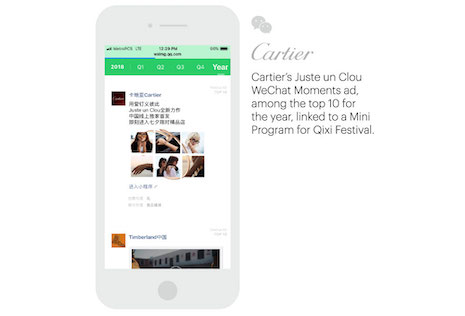
GlobalWebEx has found that Chinese consumers are the world's largest demographic of luxury buyers. Image credit: GlobalWebEx
By Dianna Dilworth
With borders still not fully open worldwide, the largest group of luxury consumers is staying home, spelling trouble for Western brands.
Without affluent Chinese consumers traveling to North America and Europe, an ongoing simmering trade war between the United States and China, and price hikes at many Western luxury stores on the mainland, these shoppers may look to Chinese and other Asian luxury brands to fill their demand.
“The Chinese luxury buyer contributes hugely to the global luxury market, so a switch in demand toward local brands could be a considerable challenge to global luxury retailers,” said Isaac Hopkins, junior trends analyst at GlobalWebEx, London.
“Given the sheer size of the market, a shift in demand from global to local brands by Chinese consumers could be incredibly challenging for Western brands,” he said.
 Shoppers return to Chanel Shanghai on March 8. Image courtesy of Agility Research and Strategy
Shoppers return to Chanel Shanghai on March 8. Image courtesy of Agility Research and Strategy
Ahead of the curve
China has been ahead of the curve in thinking that its situation is better than the rest of the world in terms of the pandemic, although that might change with a resurgence of COVID-19 cases in the nation's capital of Beijing.
Eighty-six percent of Chinese Internet users said they were concerned about the global situation when surveyed May 19-26 by
GlobalWebIndex. Only 41 percent of these Chinese consumers said they were concerned about the situation in their own country.
Additionally, optimism for overcoming the COVID-19 coronavirus outbreak has remained incredibly high on a national level. Indeed, 92 percent of Chinese Internet users said they were optimistic that their country will overcome the virus compared to just 36 percent globally.
“This new mindset could play a role in consumers' desire to support local brands,” Mr. Hopkins said.
Louis Vuitton, Bulgari, Cartier, Gucci, Montblanc, Coach, Tiffany & Co., Piaget and Burberry are nine of the top luxury brands in China, according to Gartner. Chinese consumers shop for these Western brands at home and while on vacation abroad.
Thirty-four percent of consumers who have purchased from one of the 63 global luxury brands tracked by GlobalWebIndex in the last year were Chinese consumers, making it the largest luxury market consumer base.
“In the face of COVID-19, there’s strong optimism in China for overcoming the virus on a national level and increasing approval for how other people in the country have handled the outbreak, which might reflect a stronger feeling of solidarity in the country,” Mr. Hopkins said.
“This shift in mindset alongside a reluctance to travel internationally are likely two significant drivers toward buying local brands,” he said.
There is also very little local desire currently to travel abroad – an alarming development, given that 50 percent of Chinese consumption of luxury goods and services occurs on travel overseas.
Globally, 51 percent of Internet users have delayed purchasing a vacation because of the pandemic, and this number has risen to 61 percent in China.
While 28 percent of Chinese consumers will prioritize a vacation first once the pandemic is over, only 8 percent will prioritize a flight.
“This suggests that while the Chinese tourism market may bounce back relatively quickly – such as domestic vacations – long-distance travel abroad will take longer to return to normal,” Mr. Hopkins said. “As a result, the traditionally lucrative airport channel for luxury brands may take a significant blow, as well as high-street tourism purchases."
Another leading observer of global luxury trends concurred.
“As Chinese consumers stay home, they spend more money in the mainland, boosting sales growth in China,”said Luca Solca, managing director at
Sanford C. Bernstein, Geneva.
 Cartier's recent WeChat ad in China. Image credit: Gartner
Cartier's recent WeChat ad in China. Image credit: Gartner
Reaching Chinese consumers
As Western brands struggle to entice loyal Chinese fans, they should consider their messaging.
For instance, only 49 percent of Chinese consumers approve of brands running “normal” advertising campaigns right now, compared to a global average of 56 percent, according to GlobalWebIndex.
Compare that to the 83 percent of consumers in China who approve ads that show a brand’s response to COVID-19.
“They’re also more likely than the average global consumer to want brands to provide practical info/tips which help people deal with the situation, and to contact customers to inform them on how the brand itself is responding to the virus,” Mr. Hopkins said. “These insights will be critical to appealing to Chinese consumers right now.
“It’s also equally important to know what consumers’ purchase intentions are post-COVID,” he said.
For example, 52 percent of Chinese Internet users plan to shop online more frequently after the outbreak is over and 45 percent plan to use mobile payment services more frequently.
“This is especially relevant to the traditionally tech-cautious luxury market which should now embrace an omnichannel future which aims to replicate the in-store experience online,” Mr. Hopkins said.
Trade wars
As if the pandemic was not enough, tensions between the U.S. and China pose a potential risk for Western brands.
Another threat that looms is if Chinese consumers adopt more nationalistic ideologies and look to support more local brands.
“This could pose a potential risk, especially if they further exacerbate and stoke more nationalist preferences,” Mr. Solca said.
While Chinese consumers have not yet turned away from classic Western luxury brands in favor of more home-grown Chinese luxury brands because of these tensions, “they have been turning away from brands that have made high-profile faux pas,” Mr. Solca said.
For instance, Balenciaga, Dolce & Gabbana and Dior have all been accused of being insensitive and discriminating against Chinese people.
“More balanced Sino-American cooperation should be a positive for both the global economy and luxury goods,” Mr. Solca said.
“Chinese brands can keep customers loyal by investing in distribution, communication and management in China,” he said.
 GlobalWebEx has found that Chinese consumers are the world's largest demographic of luxury buyers. Image credit: GlobalWebEx
GlobalWebEx has found that Chinese consumers are the world's largest demographic of luxury buyers. Image credit: GlobalWebEx
 Shoppers return to Chanel Shanghai on March 8. Image courtesy of Agility Research and Strategy
Shoppers return to Chanel Shanghai on March 8. Image courtesy of Agility Research and Strategy
